Artificial Intelligence for Enhancing Human Development in Thailand
VerifiedAdded on 2022/10/06
|21
|4745
|22
Report
AI Summary
This report examines the opportunities and challenges of implementing Artificial Intelligence (AI) to enhance human development in Thailand, focusing on the healthcare sector. It identifies potential benefits, such as improved healthcare standards and economic growth, while also addressing associated risks like data bias, cultural acceptance, and ethical concerns. The report details ten key risks, categorizing them into technical, cultural, and management-related areas, and proposes strategies for risk management, including avoidance, acceptance, transference, and mitigation. Furthermore, the report emphasizes the importance of addressing budgetary constraints, skill gaps, and third-party dependencies to ensure successful AI implementation. It concludes by highlighting the positive impacts of effective risk mitigation and the potential for AI to transform Thailand's economic and social landscape.
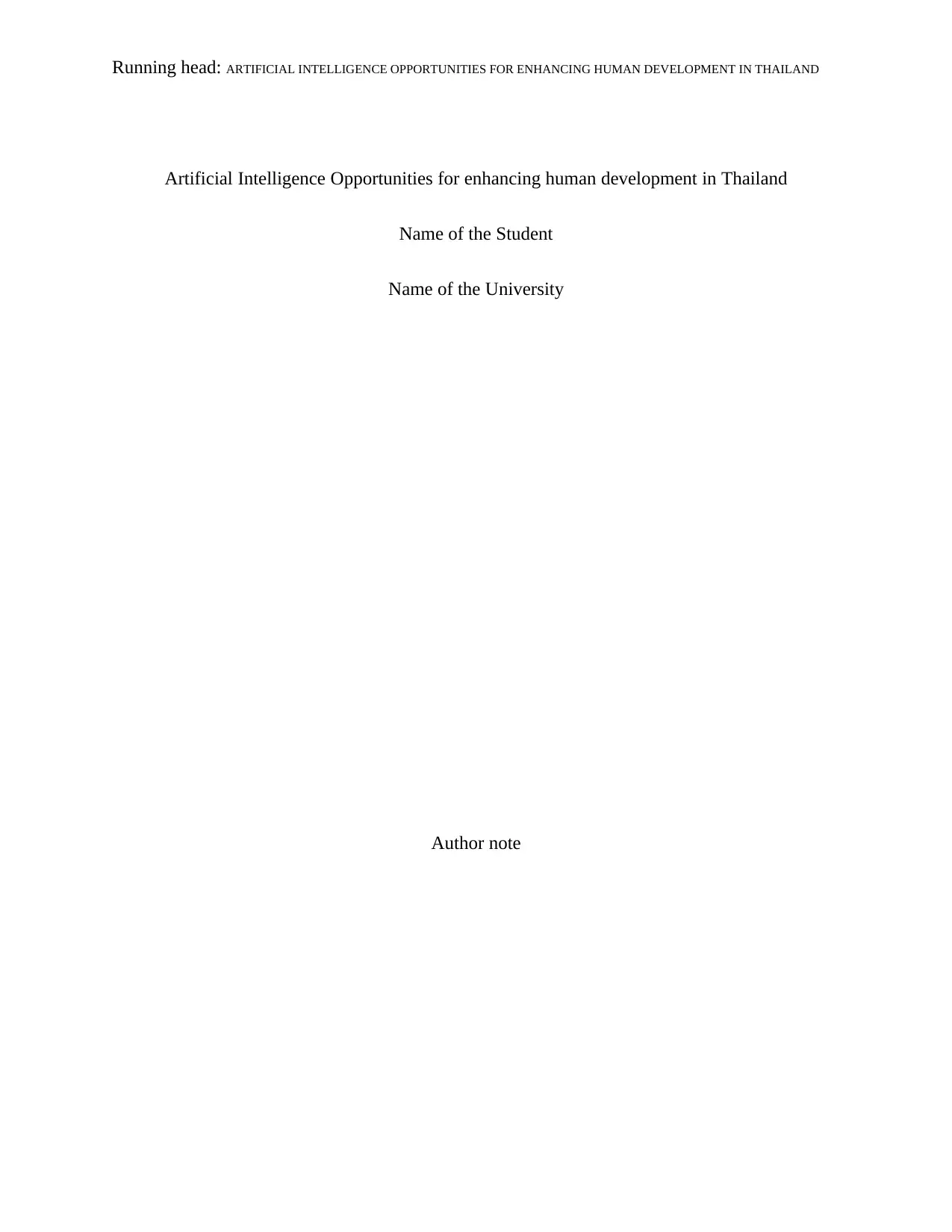
Running head: ARTIFICIAL INTELLIGENCE OPPORTUNITIES FOR ENHANCING HUMAN DEVELOPMENT IN THAILAND
Artificial Intelligence Opportunities for enhancing human development in Thailand
Name of the Student
Name of the University
Author note
Artificial Intelligence Opportunities for enhancing human development in Thailand
Name of the Student
Name of the University
Author note
Paraphrase This Document
Need a fresh take? Get an instant paraphrase of this document with our AI Paraphraser
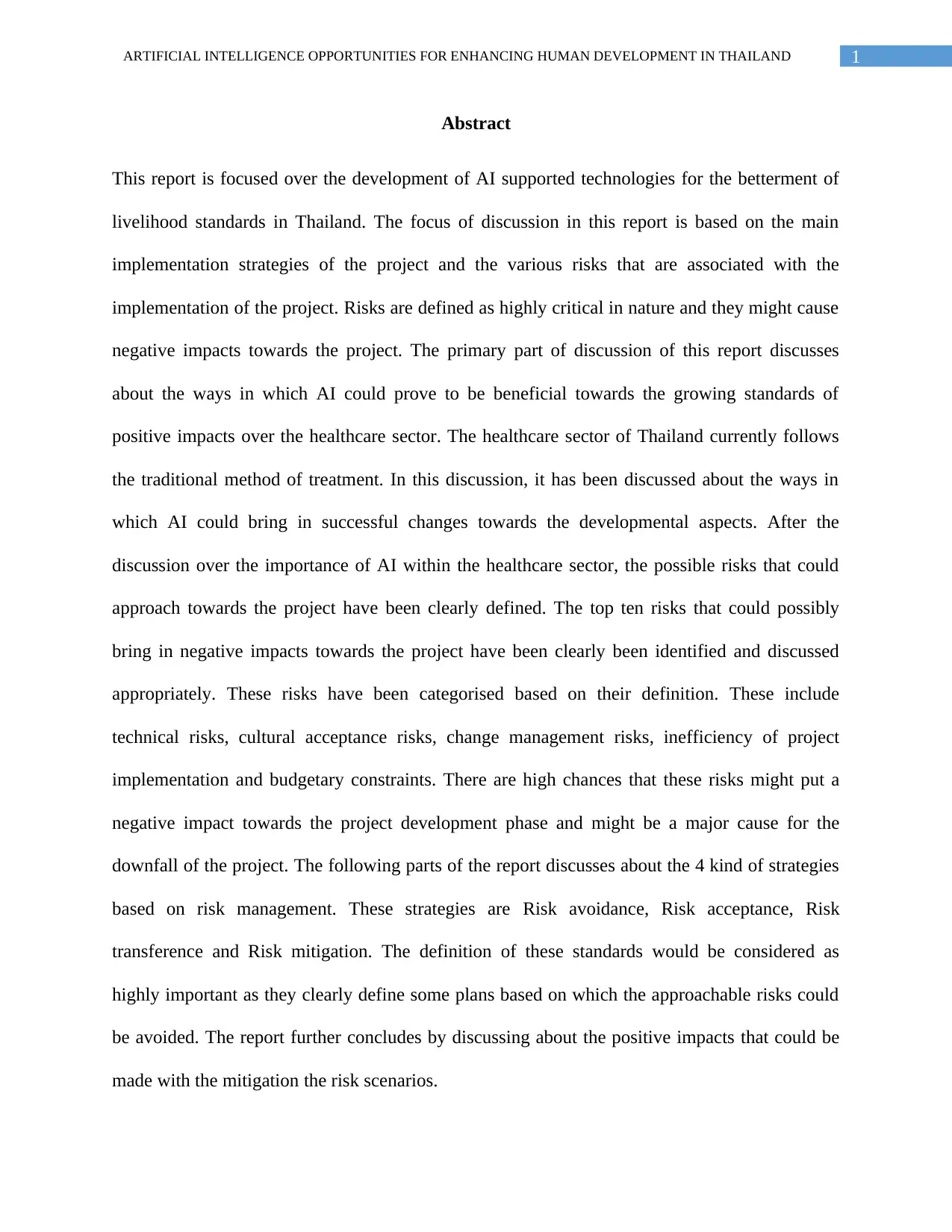
1ARTIFICIAL INTELLIGENCE OPPORTUNITIES FOR ENHANCING HUMAN DEVELOPMENT IN THAILAND
Abstract
This report is focused over the development of AI supported technologies for the betterment of
livelihood standards in Thailand. The focus of discussion in this report is based on the main
implementation strategies of the project and the various risks that are associated with the
implementation of the project. Risks are defined as highly critical in nature and they might cause
negative impacts towards the project. The primary part of discussion of this report discusses
about the ways in which AI could prove to be beneficial towards the growing standards of
positive impacts over the healthcare sector. The healthcare sector of Thailand currently follows
the traditional method of treatment. In this discussion, it has been discussed about the ways in
which AI could bring in successful changes towards the developmental aspects. After the
discussion over the importance of AI within the healthcare sector, the possible risks that could
approach towards the project have been clearly defined. The top ten risks that could possibly
bring in negative impacts towards the project have been clearly been identified and discussed
appropriately. These risks have been categorised based on their definition. These include
technical risks, cultural acceptance risks, change management risks, inefficiency of project
implementation and budgetary constraints. There are high chances that these risks might put a
negative impact towards the project development phase and might be a major cause for the
downfall of the project. The following parts of the report discusses about the 4 kind of strategies
based on risk management. These strategies are Risk avoidance, Risk acceptance, Risk
transference and Risk mitigation. The definition of these standards would be considered as
highly important as they clearly define some plans based on which the approachable risks could
be avoided. The report further concludes by discussing about the positive impacts that could be
made with the mitigation the risk scenarios.
Abstract
This report is focused over the development of AI supported technologies for the betterment of
livelihood standards in Thailand. The focus of discussion in this report is based on the main
implementation strategies of the project and the various risks that are associated with the
implementation of the project. Risks are defined as highly critical in nature and they might cause
negative impacts towards the project. The primary part of discussion of this report discusses
about the ways in which AI could prove to be beneficial towards the growing standards of
positive impacts over the healthcare sector. The healthcare sector of Thailand currently follows
the traditional method of treatment. In this discussion, it has been discussed about the ways in
which AI could bring in successful changes towards the developmental aspects. After the
discussion over the importance of AI within the healthcare sector, the possible risks that could
approach towards the project have been clearly defined. The top ten risks that could possibly
bring in negative impacts towards the project have been clearly been identified and discussed
appropriately. These risks have been categorised based on their definition. These include
technical risks, cultural acceptance risks, change management risks, inefficiency of project
implementation and budgetary constraints. There are high chances that these risks might put a
negative impact towards the project development phase and might be a major cause for the
downfall of the project. The following parts of the report discusses about the 4 kind of strategies
based on risk management. These strategies are Risk avoidance, Risk acceptance, Risk
transference and Risk mitigation. The definition of these standards would be considered as
highly important as they clearly define some plans based on which the approachable risks could
be avoided. The report further concludes by discussing about the positive impacts that could be
made with the mitigation the risk scenarios.

2ARTIFICIAL INTELLIGENCE OPPORTUNITIES FOR ENHANCING HUMAN DEVELOPMENT IN THAILAND
⊘ This is a preview!⊘
Do you want full access?
Subscribe today to unlock all pages.

Trusted by 1+ million students worldwide
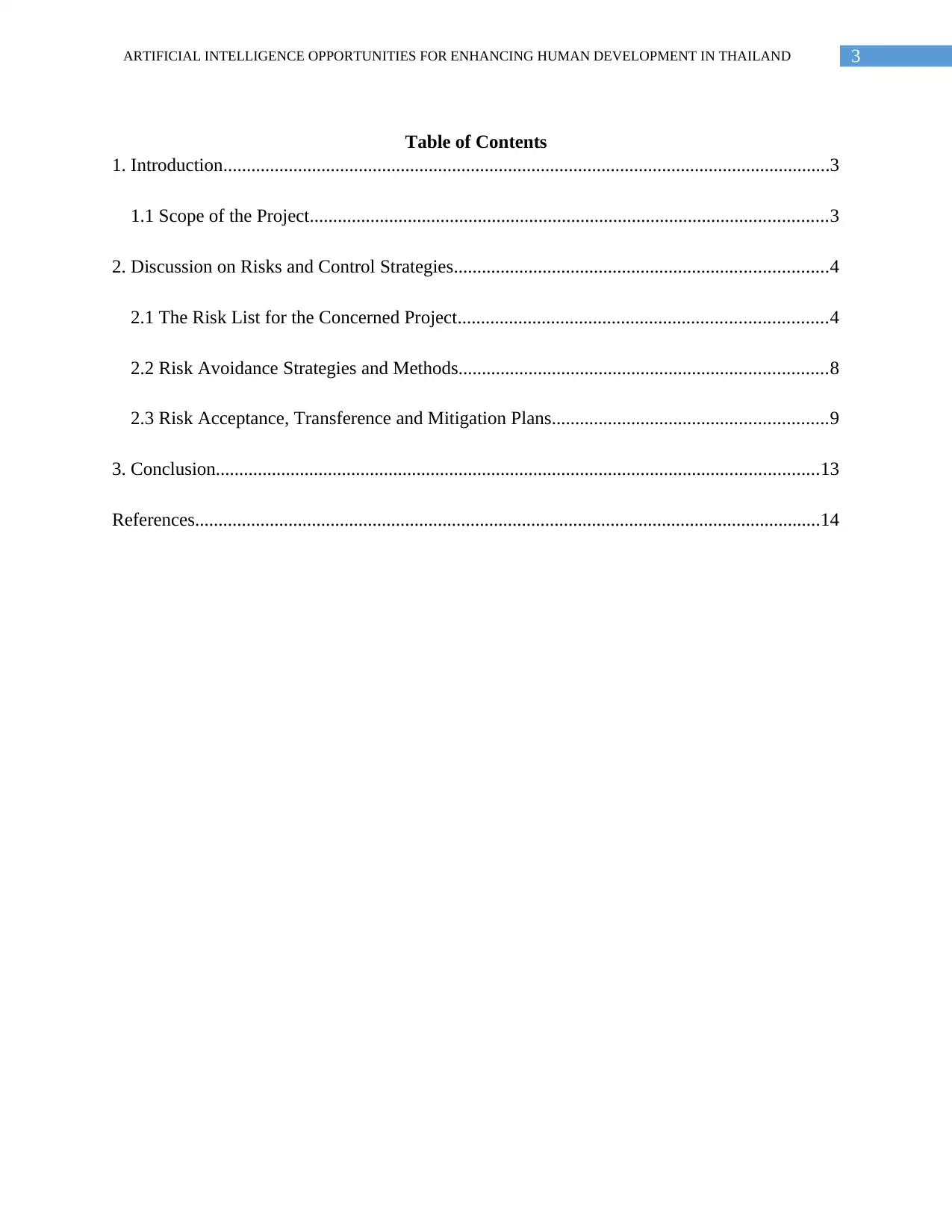
3ARTIFICIAL INTELLIGENCE OPPORTUNITIES FOR ENHANCING HUMAN DEVELOPMENT IN THAILAND
Table of Contents
1. Introduction..................................................................................................................................3
1.1 Scope of the Project...............................................................................................................3
2. Discussion on Risks and Control Strategies................................................................................4
2.1 The Risk List for the Concerned Project...............................................................................4
2.2 Risk Avoidance Strategies and Methods...............................................................................8
2.3 Risk Acceptance, Transference and Mitigation Plans...........................................................9
3. Conclusion.................................................................................................................................13
References......................................................................................................................................14
Table of Contents
1. Introduction..................................................................................................................................3
1.1 Scope of the Project...............................................................................................................3
2. Discussion on Risks and Control Strategies................................................................................4
2.1 The Risk List for the Concerned Project...............................................................................4
2.2 Risk Avoidance Strategies and Methods...............................................................................8
2.3 Risk Acceptance, Transference and Mitigation Plans...........................................................9
3. Conclusion.................................................................................................................................13
References......................................................................................................................................14
Paraphrase This Document
Need a fresh take? Get an instant paraphrase of this document with our AI Paraphraser

4ARTIFICIAL INTELLIGENCE OPPORTUNITIES FOR ENHANCING HUMAN DEVELOPMENT IN THAILAND
1. Introduction
1.1 Scope of the Project
The use of Big Data and Artificial Intelligence could be defined as an enormous approach
towards the development aspects of the sustainability standards. This discussion would be
focused over presenting various kind of opportunities towards the development of economic
standards, living standards and highly contribute towards the vision of Thailand 4.0. This is
defined as a new based economic model that is primarily driven by creativity, innovation and
technology. With the implementation of AI supported technologies, it would prove to unlock
different benefits and unlocking the challenges faced by the country due to economic challenges
(Jones and Pimdee 2017). One of the core aspect that would be followed with the impact of
Thailand 4.0 is based on the emphasis of their objectives based on the development of new form
of S-Curve industries. The development of AI supported technologies within Thailand 4.0 would
include the investment within robotics, digital technologies and the development framework of a
medical hub.
In the recent times, the digital economy is based on the extensive support from Big Data
and AI supported technological systems. The AI systems have an immense capability of handling
large amount of unprocessed data that are gathered from a vast number of sources. However,
with the proliferation of data being collected, processed, analysed and further generation of
results, there are major challenges that are being faced by the technical experts in dealing with
certain kind of risks that are approaching towards the systems (Ziuziański, Furmankiewicz and
Sołtysik-Piorunkiewicz 2014). This discussion is focused over the various kind of risks that are
being generated with the implementation of AI supported technologies. Different risks based on
1. Introduction
1.1 Scope of the Project
The use of Big Data and Artificial Intelligence could be defined as an enormous approach
towards the development aspects of the sustainability standards. This discussion would be
focused over presenting various kind of opportunities towards the development of economic
standards, living standards and highly contribute towards the vision of Thailand 4.0. This is
defined as a new based economic model that is primarily driven by creativity, innovation and
technology. With the implementation of AI supported technologies, it would prove to unlock
different benefits and unlocking the challenges faced by the country due to economic challenges
(Jones and Pimdee 2017). One of the core aspect that would be followed with the impact of
Thailand 4.0 is based on the emphasis of their objectives based on the development of new form
of S-Curve industries. The development of AI supported technologies within Thailand 4.0 would
include the investment within robotics, digital technologies and the development framework of a
medical hub.
In the recent times, the digital economy is based on the extensive support from Big Data
and AI supported technological systems. The AI systems have an immense capability of handling
large amount of unprocessed data that are gathered from a vast number of sources. However,
with the proliferation of data being collected, processed, analysed and further generation of
results, there are major challenges that are being faced by the technical experts in dealing with
certain kind of risks that are approaching towards the systems (Ziuziański, Furmankiewicz and
Sołtysik-Piorunkiewicz 2014). This discussion is focused over the various kind of risks that are
being generated with the implementation of AI supported technologies. Different risks based on
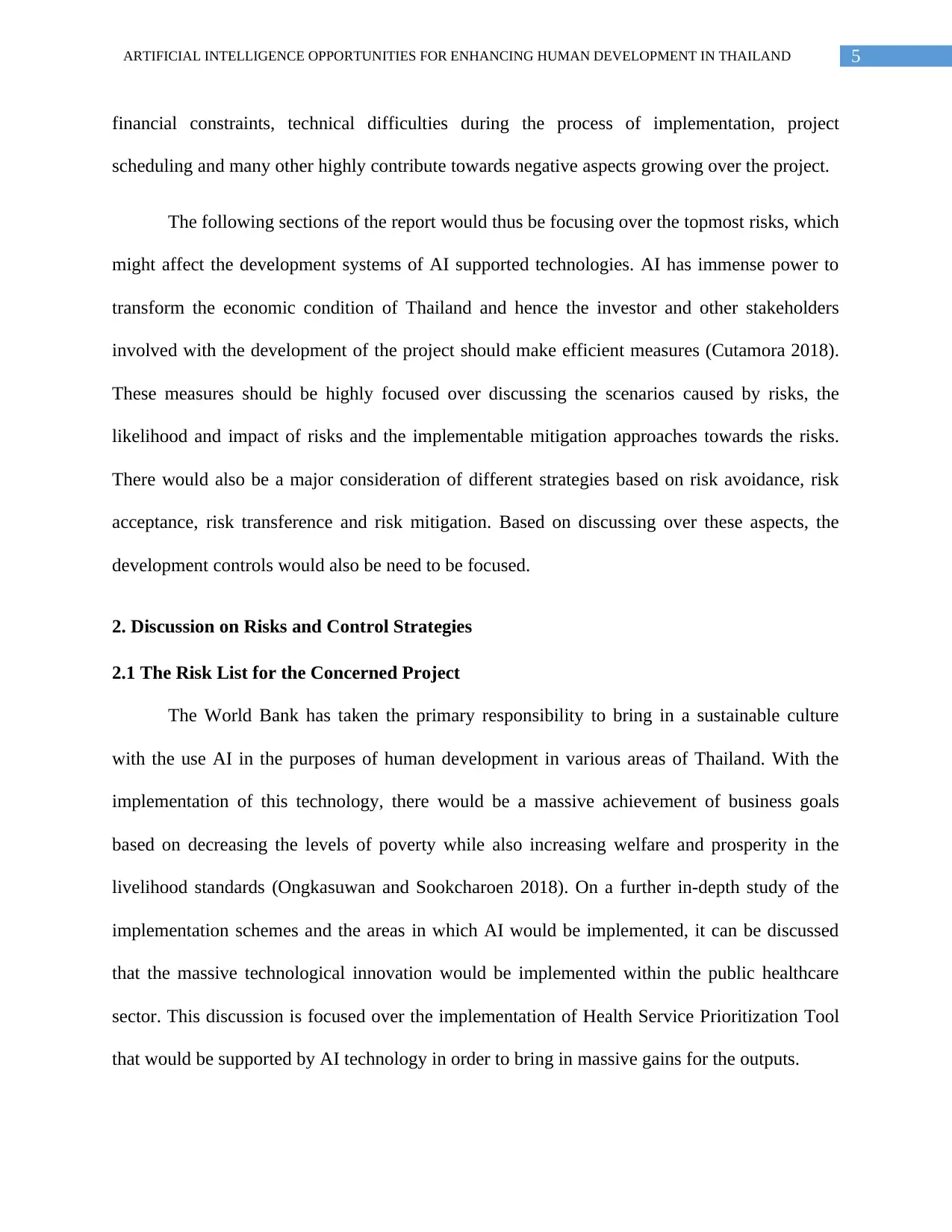
5ARTIFICIAL INTELLIGENCE OPPORTUNITIES FOR ENHANCING HUMAN DEVELOPMENT IN THAILAND
financial constraints, technical difficulties during the process of implementation, project
scheduling and many other highly contribute towards negative aspects growing over the project.
The following sections of the report would thus be focusing over the topmost risks, which
might affect the development systems of AI supported technologies. AI has immense power to
transform the economic condition of Thailand and hence the investor and other stakeholders
involved with the development of the project should make efficient measures (Cutamora 2018).
These measures should be highly focused over discussing the scenarios caused by risks, the
likelihood and impact of risks and the implementable mitigation approaches towards the risks.
There would also be a major consideration of different strategies based on risk avoidance, risk
acceptance, risk transference and risk mitigation. Based on discussing over these aspects, the
development controls would also be need to be focused.
2. Discussion on Risks and Control Strategies
2.1 The Risk List for the Concerned Project
The World Bank has taken the primary responsibility to bring in a sustainable culture
with the use AI in the purposes of human development in various areas of Thailand. With the
implementation of this technology, there would be a massive achievement of business goals
based on decreasing the levels of poverty while also increasing welfare and prosperity in the
livelihood standards (Ongkasuwan and Sookcharoen 2018). On a further in-depth study of the
implementation schemes and the areas in which AI would be implemented, it can be discussed
that the massive technological innovation would be implemented within the public healthcare
sector. This discussion is focused over the implementation of Health Service Prioritization Tool
that would be supported by AI technology in order to bring in massive gains for the outputs.
financial constraints, technical difficulties during the process of implementation, project
scheduling and many other highly contribute towards negative aspects growing over the project.
The following sections of the report would thus be focusing over the topmost risks, which
might affect the development systems of AI supported technologies. AI has immense power to
transform the economic condition of Thailand and hence the investor and other stakeholders
involved with the development of the project should make efficient measures (Cutamora 2018).
These measures should be highly focused over discussing the scenarios caused by risks, the
likelihood and impact of risks and the implementable mitigation approaches towards the risks.
There would also be a major consideration of different strategies based on risk avoidance, risk
acceptance, risk transference and risk mitigation. Based on discussing over these aspects, the
development controls would also be need to be focused.
2. Discussion on Risks and Control Strategies
2.1 The Risk List for the Concerned Project
The World Bank has taken the primary responsibility to bring in a sustainable culture
with the use AI in the purposes of human development in various areas of Thailand. With the
implementation of this technology, there would be a massive achievement of business goals
based on decreasing the levels of poverty while also increasing welfare and prosperity in the
livelihood standards (Ongkasuwan and Sookcharoen 2018). On a further in-depth study of the
implementation schemes and the areas in which AI would be implemented, it can be discussed
that the massive technological innovation would be implemented within the public healthcare
sector. This discussion is focused over the implementation of Health Service Prioritization Tool
that would be supported by AI technology in order to bring in massive gains for the outputs.
⊘ This is a preview!⊘
Do you want full access?
Subscribe today to unlock all pages.

Trusted by 1+ million students worldwide
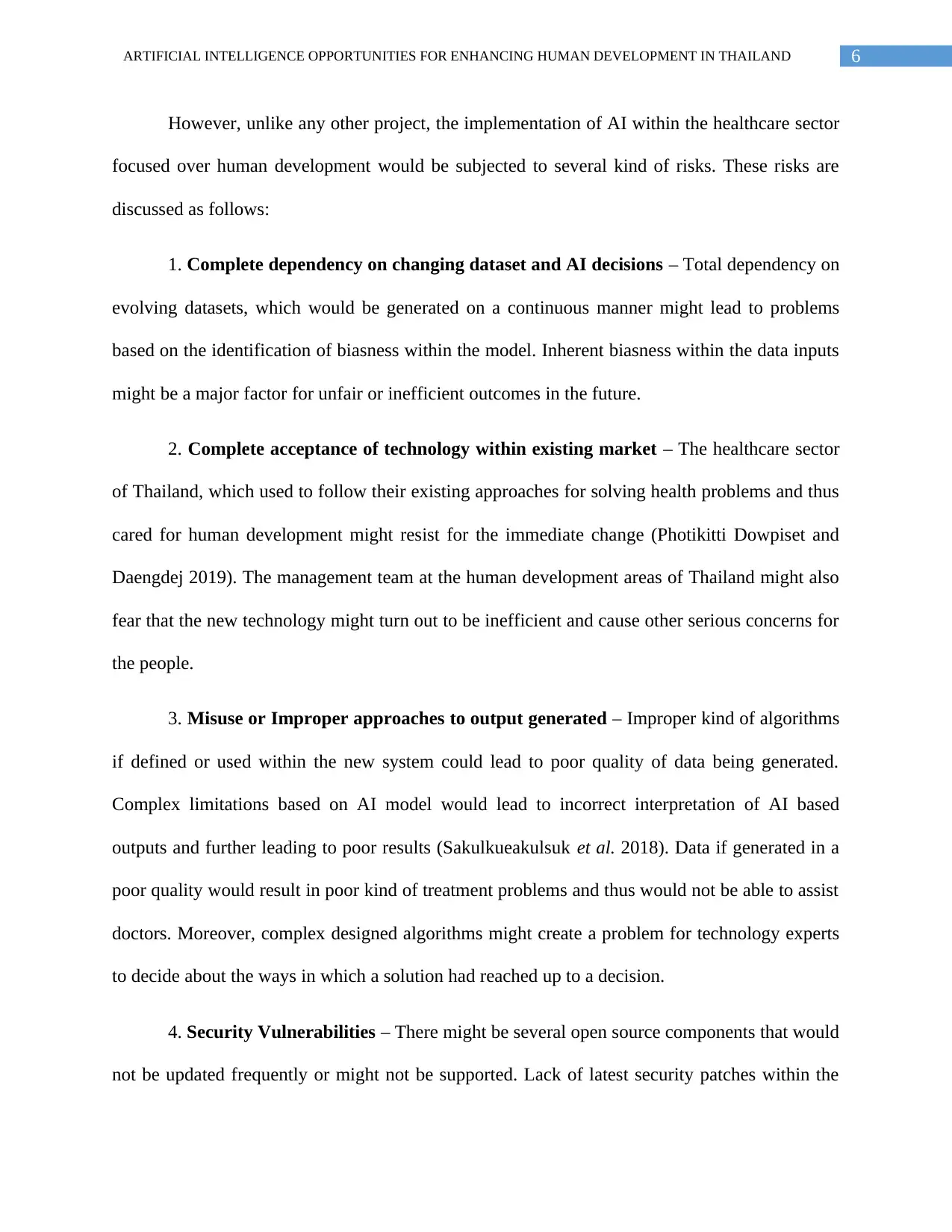
6ARTIFICIAL INTELLIGENCE OPPORTUNITIES FOR ENHANCING HUMAN DEVELOPMENT IN THAILAND
However, unlike any other project, the implementation of AI within the healthcare sector
focused over human development would be subjected to several kind of risks. These risks are
discussed as follows:
1. Complete dependency on changing dataset and AI decisions – Total dependency on
evolving datasets, which would be generated on a continuous manner might lead to problems
based on the identification of biasness within the model. Inherent biasness within the data inputs
might be a major factor for unfair or inefficient outcomes in the future.
2. Complete acceptance of technology within existing market – The healthcare sector
of Thailand, which used to follow their existing approaches for solving health problems and thus
cared for human development might resist for the immediate change (Photikitti Dowpiset and
Daengdej 2019). The management team at the human development areas of Thailand might also
fear that the new technology might turn out to be inefficient and cause other serious concerns for
the people.
3. Misuse or Improper approaches to output generated – Improper kind of algorithms
if defined or used within the new system could lead to poor quality of data being generated.
Complex limitations based on AI model would lead to incorrect interpretation of AI based
outputs and further leading to poor results (Sakulkueakulsuk et al. 2018). Data if generated in a
poor quality would result in poor kind of treatment problems and thus would not be able to assist
doctors. Moreover, complex designed algorithms might create a problem for technology experts
to decide about the ways in which a solution had reached up to a decision.
4. Security Vulnerabilities – There might be several open source components that would
not be updated frequently or might not be supported. Lack of latest security patches within the
However, unlike any other project, the implementation of AI within the healthcare sector
focused over human development would be subjected to several kind of risks. These risks are
discussed as follows:
1. Complete dependency on changing dataset and AI decisions – Total dependency on
evolving datasets, which would be generated on a continuous manner might lead to problems
based on the identification of biasness within the model. Inherent biasness within the data inputs
might be a major factor for unfair or inefficient outcomes in the future.
2. Complete acceptance of technology within existing market – The healthcare sector
of Thailand, which used to follow their existing approaches for solving health problems and thus
cared for human development might resist for the immediate change (Photikitti Dowpiset and
Daengdej 2019). The management team at the human development areas of Thailand might also
fear that the new technology might turn out to be inefficient and cause other serious concerns for
the people.
3. Misuse or Improper approaches to output generated – Improper kind of algorithms
if defined or used within the new system could lead to poor quality of data being generated.
Complex limitations based on AI model would lead to incorrect interpretation of AI based
outputs and further leading to poor results (Sakulkueakulsuk et al. 2018). Data if generated in a
poor quality would result in poor kind of treatment problems and thus would not be able to assist
doctors. Moreover, complex designed algorithms might create a problem for technology experts
to decide about the ways in which a solution had reached up to a decision.
4. Security Vulnerabilities – There might be several open source components that would
not be updated frequently or might not be supported. Lack of latest security patches within the
Paraphrase This Document
Need a fresh take? Get an instant paraphrase of this document with our AI Paraphraser

7ARTIFICIAL INTELLIGENCE OPPORTUNITIES FOR ENHANCING HUMAN DEVELOPMENT IN THAILAND
software might lead to security vulnerabilities affecting the system and this might cause future
problems for the software engineers in locating the exact issue that has raised (Harini and Rao
2019). Complex algorithms might be a leading factor for malicious manipulation by machines
and humans. There might also be a problem with the immediate risk based on security breaches
within the data collected. The AI algorithms might change their working functionalities
according to the changing scenarios. However, any kind of manipulation within the internal data
would lead to posing of security risks based on which there might be a problem based on
interaction.
5. Change Management Problems – There might be some kind of instances in which
there are existing IT legacy systems infrastructure. These might not be compatible with the
newly defined AI supported infrastructural systems. The existing legacy systems might not be
able to process the data gathered by the internal systems (Kawtrakul and Praneetpolgrang 2014).
There might be some kind of complex AI applications, which would be defined for the
healthcare sector. These might create some complications based on making necessary decisions
within complex form of AI applications. Hidden decision-making layers present within the
neural networks might create a problem for understanding of the quick decisions made by the
systems.
6. Compatibility with Culture and Product Innovation – The deployment of AI
supported technology might not meet with the increasing demands of customers. There are some
kind of major problems, which needs to be addressed at an early phase (He et al. 2019). AI
supported technologies might not be able to provide better outcomes as was expected during the
development of the products.
software might lead to security vulnerabilities affecting the system and this might cause future
problems for the software engineers in locating the exact issue that has raised (Harini and Rao
2019). Complex algorithms might be a leading factor for malicious manipulation by machines
and humans. There might also be a problem with the immediate risk based on security breaches
within the data collected. The AI algorithms might change their working functionalities
according to the changing scenarios. However, any kind of manipulation within the internal data
would lead to posing of security risks based on which there might be a problem based on
interaction.
5. Change Management Problems – There might be some kind of instances in which
there are existing IT legacy systems infrastructure. These might not be compatible with the
newly defined AI supported infrastructural systems. The existing legacy systems might not be
able to process the data gathered by the internal systems (Kawtrakul and Praneetpolgrang 2014).
There might be some kind of complex AI applications, which would be defined for the
healthcare sector. These might create some complications based on making necessary decisions
within complex form of AI applications. Hidden decision-making layers present within the
neural networks might create a problem for understanding of the quick decisions made by the
systems.
6. Compatibility with Culture and Product Innovation – The deployment of AI
supported technology might not meet with the increasing demands of customers. There are some
kind of major problems, which needs to be addressed at an early phase (He et al. 2019). AI
supported technologies might not be able to provide better outcomes as was expected during the
development of the products.
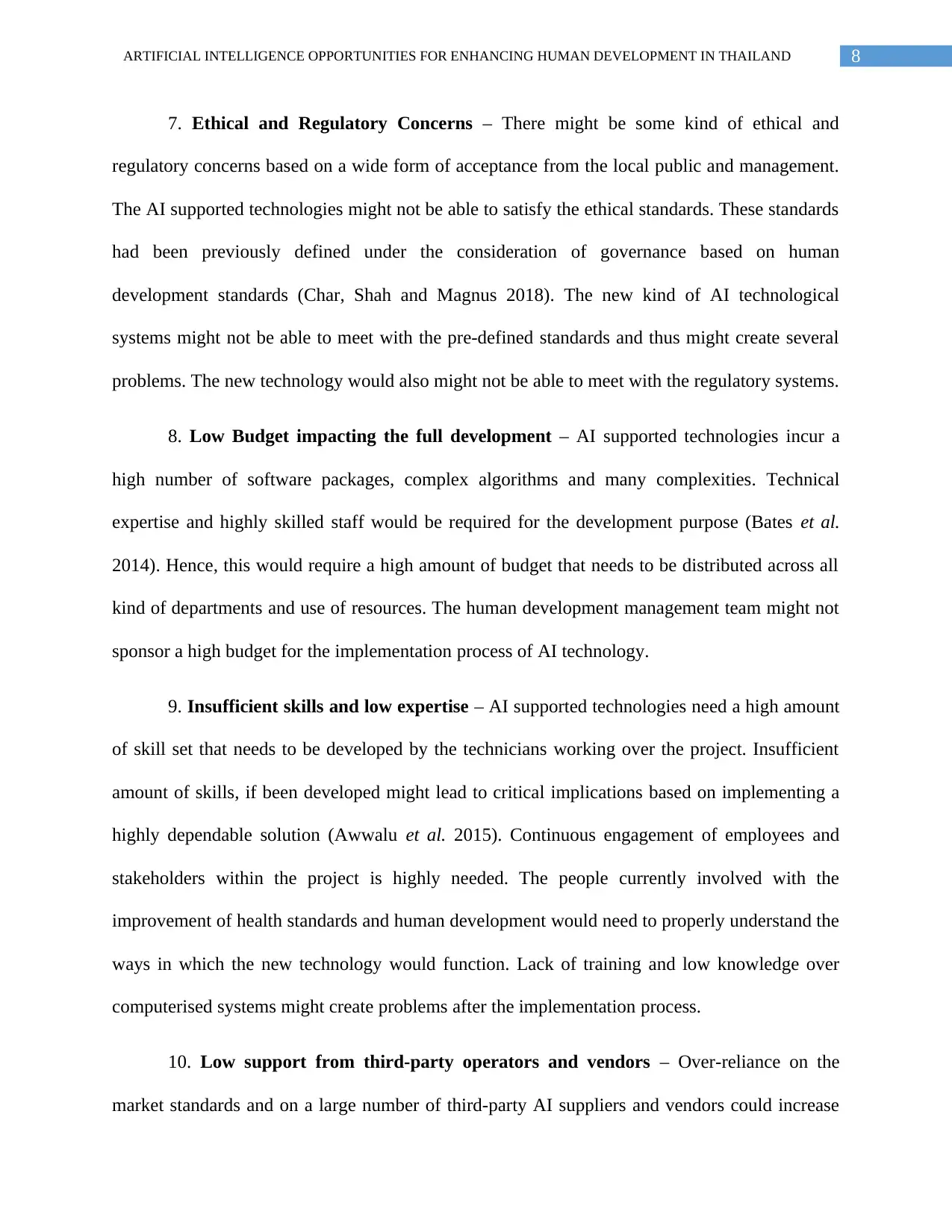
8ARTIFICIAL INTELLIGENCE OPPORTUNITIES FOR ENHANCING HUMAN DEVELOPMENT IN THAILAND
7. Ethical and Regulatory Concerns – There might be some kind of ethical and
regulatory concerns based on a wide form of acceptance from the local public and management.
The AI supported technologies might not be able to satisfy the ethical standards. These standards
had been previously defined under the consideration of governance based on human
development standards (Char, Shah and Magnus 2018). The new kind of AI technological
systems might not be able to meet with the pre-defined standards and thus might create several
problems. The new technology would also might not be able to meet with the regulatory systems.
8. Low Budget impacting the full development – AI supported technologies incur a
high number of software packages, complex algorithms and many complexities. Technical
expertise and highly skilled staff would be required for the development purpose (Bates et al.
2014). Hence, this would require a high amount of budget that needs to be distributed across all
kind of departments and use of resources. The human development management team might not
sponsor a high budget for the implementation process of AI technology.
9. Insufficient skills and low expertise – AI supported technologies need a high amount
of skill set that needs to be developed by the technicians working over the project. Insufficient
amount of skills, if been developed might lead to critical implications based on implementing a
highly dependable solution (Awwalu et al. 2015). Continuous engagement of employees and
stakeholders within the project is highly needed. The people currently involved with the
improvement of health standards and human development would need to properly understand the
ways in which the new technology would function. Lack of training and low knowledge over
computerised systems might create problems after the implementation process.
10. Low support from third-party operators and vendors – Over-reliance on the
market standards and on a large number of third-party AI suppliers and vendors could increase
7. Ethical and Regulatory Concerns – There might be some kind of ethical and
regulatory concerns based on a wide form of acceptance from the local public and management.
The AI supported technologies might not be able to satisfy the ethical standards. These standards
had been previously defined under the consideration of governance based on human
development standards (Char, Shah and Magnus 2018). The new kind of AI technological
systems might not be able to meet with the pre-defined standards and thus might create several
problems. The new technology would also might not be able to meet with the regulatory systems.
8. Low Budget impacting the full development – AI supported technologies incur a
high number of software packages, complex algorithms and many complexities. Technical
expertise and highly skilled staff would be required for the development purpose (Bates et al.
2014). Hence, this would require a high amount of budget that needs to be distributed across all
kind of departments and use of resources. The human development management team might not
sponsor a high budget for the implementation process of AI technology.
9. Insufficient skills and low expertise – AI supported technologies need a high amount
of skill set that needs to be developed by the technicians working over the project. Insufficient
amount of skills, if been developed might lead to critical implications based on implementing a
highly dependable solution (Awwalu et al. 2015). Continuous engagement of employees and
stakeholders within the project is highly needed. The people currently involved with the
improvement of health standards and human development would need to properly understand the
ways in which the new technology would function. Lack of training and low knowledge over
computerised systems might create problems after the implementation process.
10. Low support from third-party operators and vendors – Over-reliance on the
market standards and on a large number of third-party AI suppliers and vendors could increase
⊘ This is a preview!⊘
Do you want full access?
Subscribe today to unlock all pages.

Trusted by 1+ million students worldwide
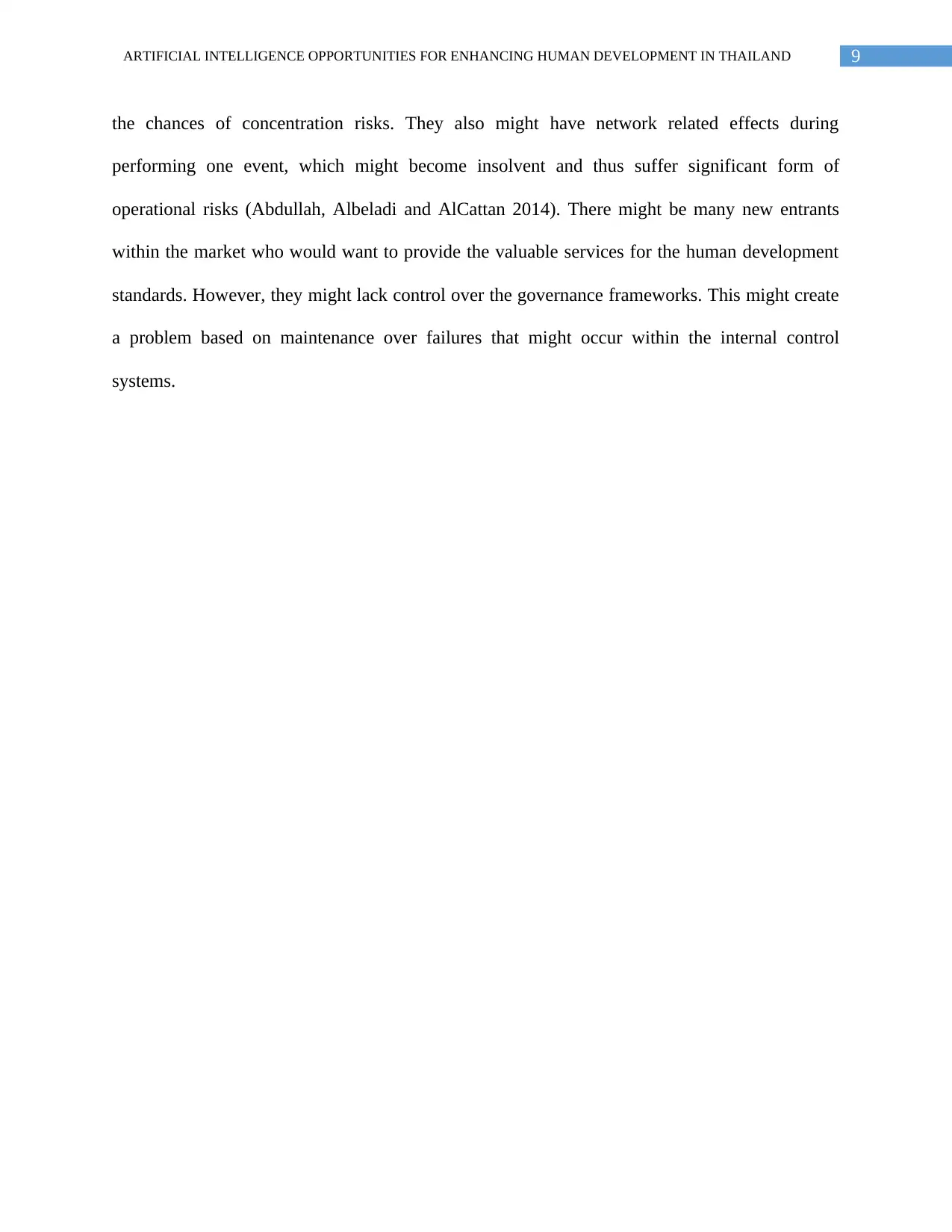
9ARTIFICIAL INTELLIGENCE OPPORTUNITIES FOR ENHANCING HUMAN DEVELOPMENT IN THAILAND
the chances of concentration risks. They also might have network related effects during
performing one event, which might become insolvent and thus suffer significant form of
operational risks (Abdullah, Albeladi and AlCattan 2014). There might be many new entrants
within the market who would want to provide the valuable services for the human development
standards. However, they might lack control over the governance frameworks. This might create
a problem based on maintenance over failures that might occur within the internal control
systems.
the chances of concentration risks. They also might have network related effects during
performing one event, which might become insolvent and thus suffer significant form of
operational risks (Abdullah, Albeladi and AlCattan 2014). There might be many new entrants
within the market who would want to provide the valuable services for the human development
standards. However, they might lack control over the governance frameworks. This might create
a problem based on maintenance over failures that might occur within the internal control
systems.
Paraphrase This Document
Need a fresh take? Get an instant paraphrase of this document with our AI Paraphraser
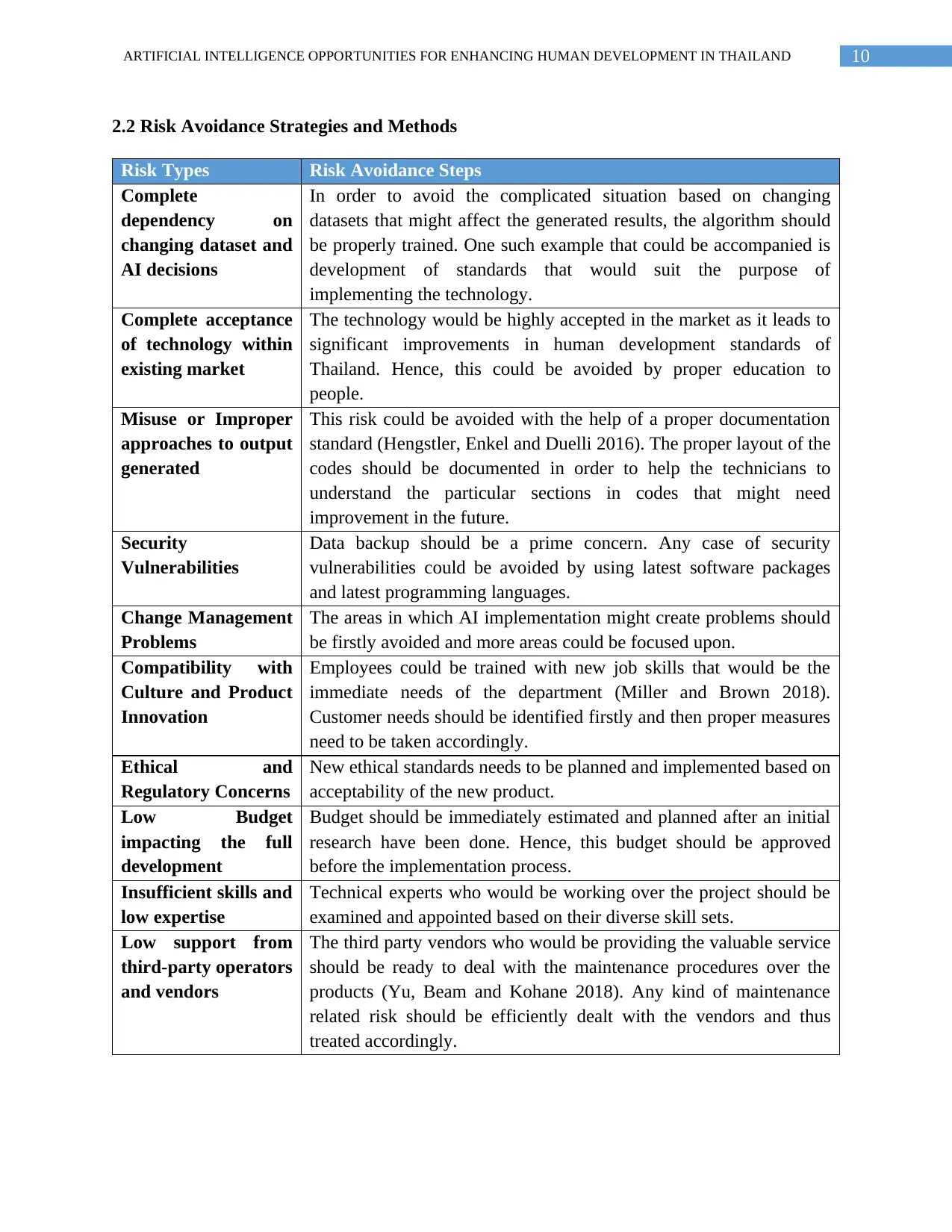
10ARTIFICIAL INTELLIGENCE OPPORTUNITIES FOR ENHANCING HUMAN DEVELOPMENT IN THAILAND
2.2 Risk Avoidance Strategies and Methods
Risk Types Risk Avoidance Steps
Complete
dependency on
changing dataset and
AI decisions
In order to avoid the complicated situation based on changing
datasets that might affect the generated results, the algorithm should
be properly trained. One such example that could be accompanied is
development of standards that would suit the purpose of
implementing the technology.
Complete acceptance
of technology within
existing market
The technology would be highly accepted in the market as it leads to
significant improvements in human development standards of
Thailand. Hence, this could be avoided by proper education to
people.
Misuse or Improper
approaches to output
generated
This risk could be avoided with the help of a proper documentation
standard (Hengstler, Enkel and Duelli 2016). The proper layout of the
codes should be documented in order to help the technicians to
understand the particular sections in codes that might need
improvement in the future.
Security
Vulnerabilities
Data backup should be a prime concern. Any case of security
vulnerabilities could be avoided by using latest software packages
and latest programming languages.
Change Management
Problems
The areas in which AI implementation might create problems should
be firstly avoided and more areas could be focused upon.
Compatibility with
Culture and Product
Innovation
Employees could be trained with new job skills that would be the
immediate needs of the department (Miller and Brown 2018).
Customer needs should be identified firstly and then proper measures
need to be taken accordingly.
Ethical and
Regulatory Concerns
New ethical standards needs to be planned and implemented based on
acceptability of the new product.
Low Budget
impacting the full
development
Budget should be immediately estimated and planned after an initial
research have been done. Hence, this budget should be approved
before the implementation process.
Insufficient skills and
low expertise
Technical experts who would be working over the project should be
examined and appointed based on their diverse skill sets.
Low support from
third-party operators
and vendors
The third party vendors who would be providing the valuable service
should be ready to deal with the maintenance procedures over the
products (Yu, Beam and Kohane 2018). Any kind of maintenance
related risk should be efficiently dealt with the vendors and thus
treated accordingly.
2.2 Risk Avoidance Strategies and Methods
Risk Types Risk Avoidance Steps
Complete
dependency on
changing dataset and
AI decisions
In order to avoid the complicated situation based on changing
datasets that might affect the generated results, the algorithm should
be properly trained. One such example that could be accompanied is
development of standards that would suit the purpose of
implementing the technology.
Complete acceptance
of technology within
existing market
The technology would be highly accepted in the market as it leads to
significant improvements in human development standards of
Thailand. Hence, this could be avoided by proper education to
people.
Misuse or Improper
approaches to output
generated
This risk could be avoided with the help of a proper documentation
standard (Hengstler, Enkel and Duelli 2016). The proper layout of the
codes should be documented in order to help the technicians to
understand the particular sections in codes that might need
improvement in the future.
Security
Vulnerabilities
Data backup should be a prime concern. Any case of security
vulnerabilities could be avoided by using latest software packages
and latest programming languages.
Change Management
Problems
The areas in which AI implementation might create problems should
be firstly avoided and more areas could be focused upon.
Compatibility with
Culture and Product
Innovation
Employees could be trained with new job skills that would be the
immediate needs of the department (Miller and Brown 2018).
Customer needs should be identified firstly and then proper measures
need to be taken accordingly.
Ethical and
Regulatory Concerns
New ethical standards needs to be planned and implemented based on
acceptability of the new product.
Low Budget
impacting the full
development
Budget should be immediately estimated and planned after an initial
research have been done. Hence, this budget should be approved
before the implementation process.
Insufficient skills and
low expertise
Technical experts who would be working over the project should be
examined and appointed based on their diverse skill sets.
Low support from
third-party operators
and vendors
The third party vendors who would be providing the valuable service
should be ready to deal with the maintenance procedures over the
products (Yu, Beam and Kohane 2018). Any kind of maintenance
related risk should be efficiently dealt with the vendors and thus
treated accordingly.

11ARTIFICIAL INTELLIGENCE OPPORTUNITIES FOR ENHANCING HUMAN DEVELOPMENT IN THAILAND
⊘ This is a preview!⊘
Do you want full access?
Subscribe today to unlock all pages.

Trusted by 1+ million students worldwide
1 out of 21
Related Documents
Your All-in-One AI-Powered Toolkit for Academic Success.
+13062052269
info@desklib.com
Available 24*7 on WhatsApp / Email
![[object Object]](/_next/static/media/star-bottom.7253800d.svg)
Unlock your academic potential
Copyright © 2020–2025 A2Z Services. All Rights Reserved. Developed and managed by ZUCOL.




